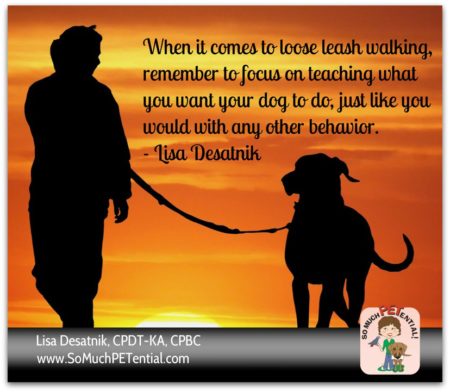Is it an issue of having more control?
The other day I began working with a client (and his dog) on loose leash walking skills. As I initially watched them walk together, I saw that, while they walked side-by-side without distractions, if Fido’s nose picked up on something to sniff, he simply stopped to sniff while his owner stopped with him. And, if Fido saw something ahead that he wanted to get closer to, he walked faster to the end of the leash until it was taught.
 Why was this happening? Was this an example of a bad, stubborn who needed to be controlled better by his handler?
Why was this happening? Was this an example of a bad, stubborn who needed to be controlled better by his handler?
Not from my eyes. What I observed was a dog who was simply making behavior choices based upon where the value was for him. There is great sensory stimulation for sniffing; and, as for the pulling, well, it worked to get them to move toward what it was he wanted to get closer to. He was also saying with his actions that there was far greater reinforcement history with stopping when he wanted to sniff or pulling on the leash to go forward, than there was to walking by his handler’s side.
Note: In a previous post, I shared some of the reasons why people have problems with loose leash walking their dog. You can read them here.
Something else that I observed what that his handler had not taught him with clarity as to what ‘he’ wanted Fido TO DO when the leash was connecting the two of them; and without that clarity, Fido made his own choices for getting what he wanted.
Always when working on solving pet behavior issues, I like to work from a standpoint of focusing on what it is you WANT your pet to do instead of focusing on stopping the unwanted behavior; while preventing or at least minimizing opportunity for practice of the unwanted behavior – and especially for reinforcement of the unwanted behavior.
I won’t get into the mechanics here but with loose leash walking, that means spending time teaching your dog how you WANT him to walk on a leash (whether by your side or simply with a loose lead) with positive reinforcement. And, as for those distractions, instead of keeping them off limits to your dog, think of them as powerful positive reinforcement tools you can use in your training kit. You can teach your dog that walking a few steps by your side earns him the opportunity to go sniff that incredible fire hydrant; or that walking next to you and sitting or stopping when you stop gives him the opportunity to say hello to that person across the street.
Stop thinking about controlling your pet, and switch to controlling the consequences of your pet’s behavior. And always remember to have fun along the way.
Can I be of further help to you and your pet? Please contact me!






